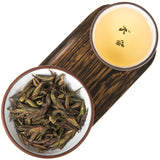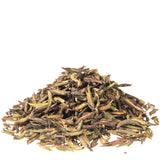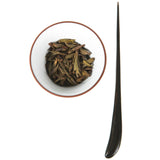One chilly winter day, Lao Cha was traveling through the mountainous terrains of Yunnan. There, he saw many wild trees, some towering above his head. Although it was cold, the tea trees had developed shoots resembling those of young bamboo.
He picked a few, started a campfire, and infused the shoots in a cup of boiling water. The taste was like no tea he's had before — crisp, filled with notes of wild berries, pine needles, and everlasting sweetness.
Lao Cha knew that he only needed a few to make tea that would last through numerous infusions, so he didn't hesitate to gather the Yabao buds before continuing on his journey.
Ya Bao is a fascinating specialty tea. Some consider it a raw pu-erh, others for white tea. Sometimes it even goes by the name of "white pu-erh".
Yabao consists solely of buds and has a light, crisp, and refreshing taste. Yabao buds are very young shoots that develop into offshoot branches. Usually, farmers pick them in winter and early spring. They dry the buds in the sun without any additional processing.
The buds are very forgiving of brewing, should you try this tea. You can experiment and try it in any way you like. For example, it's delightful when enjoyed grandpa-style, as the tea buds sink to the bottom. There, they continue to infuse the brew with their sweet nectar, void of any bitter notes. So it becomes a fantastic travel tea! The aroma is reminiscent of pine forests and the berries that grow there.

Ya Bao tea, harvested from the "Wild Purple Bamboo shoots" (Ye Sheng Zi Sun – 野生紫笋) varietal, is considered to have extremely low caffeine levels or even zero caffeine!
Ya Bao is often referred to as “purple tea” due to its rich content of anthocyanin, the same antioxidant found in fruits and vegetables that are blue or purple, such as blueberries.
Zisun wild tea trees survive and grow primarily in the forests of southwestern Yunnan, reaching altitudes of over 2,000 meters above sea level. There, they coexist with other tree species.
Our Ya Bao's purple buds are shaped like bamboo shoots, tightly wrapped. They produce a fragrant yellow tea soup when mixed with boiling water. Its tender and distinctive aroma contains notes of wild berries. The taste is refreshing and full of spirit. Being the first spring tea picked on this land, the Chinese believe it captures and stores the vital essence of spring in its tender shoots. Therefore, it is a prized experience in early springtime.

Mr. Yang and Mr. Zhang are two tea-making partners living in Pu-erh, Yunnan. They are knowledgeable, innovative, curious, and not afraid to experiment. Yang and Zhang specialize in making teas using cultivars brought from Taiwan. They also work extensively with the ancient wild trees that grow in the area.
Brewing guidelines:
![]() 212℉ / 100℃
212℉ / 100℃
 1g per 70-100ml
1g per 70-100ml ![]() 3-5min
3-5min
 1g per 20ml
1g per 20ml ![]() 10sec + 5sec for each subsequent infusion
10sec + 5sec for each subsequent infusion





